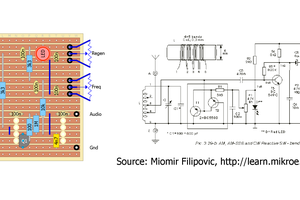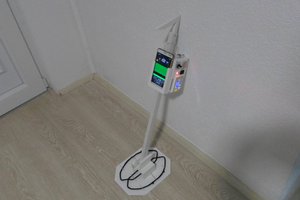In this project I will present you a Very Simple "Beat Frequency Oscillator" type of Metal Detector. BFO metal detectors are relatively simple and inexpensive compared to other types of metal detectors. It is one of the simplest and most common types of metal detectors.
The principle of operation is as follows:
When a metallic object is in close proximity to the search coil, the beat frequency produced will be different compared to when there is no metal present. This change in the beat frequency indicates the presence of a metal object and allows the user to identify and locate it.The metal detector described in this project is taken from the chemelec website with minor modifications , and is extremely simple to build, containing only three transistors. However, despite its simplicity, it gives excellent results. If properly adjusted according to the instructions, it is able to detect a small coin at a distance of 15 cm, and a large metal object at a distance of 50 cm and more.

As I mentioned earlier, the detector is extremely simple to build and contains only three transistors and a few additional passive elements (resistors and capacitors). As an indicator of the presence of a metal object, a piezo speaker, or a crystal earpiece is used, but for the purposes of the video I added small audio amplifier and speaker.

If you want to make a PCB for this project, or for any other electronic project, PCBway is a great choice for you. PCBway is one of the most experienced PCB manufacturing company in China in field of PCB prototype and fabrication. They provide completed PCB assembly service with worldwide free shipping , and ISO9001 quality control system. Also, on their site there is an online gerber viewer where you can upload your gerber and drill files to render your board.

For the inductance L1 I used a small DIP color ring inductance, but if you don't have one you can make it yourself by winding a thin insulated copper wire on a small ferrite core. The number of windings should be determined experimentally. I made the PCB for this project by hand, with a marker, and etched with hydrochloric acid and hydrogen as a catalyst, so I remembered the old days.

And now, a few words about the setting:
BFO metal detector consists of two oscillators. The reference oscillator created around L1, and search oscillator created around L2. The output signals of the reference and search oscillators are combined, creating a beat frequency audible to the human ear. When the search coil is near a metal object, it disrupts the electromagnetic field generated by the search oscillator. This disturbance affects the beat frequency produced by the oscillators, and the user can hear the changes in the audio output, such as a change in pitch or tone.
Depending on the Accuracy of the Inductance of L1, L2 and other parts, you may need to add or remove a turn or two from L2, to get both oscillators operating at the approximately same frequency. As an Alternative to adding or Removing Turns, you can wind the coil with
various taps, or change the shape of the coil. In my case, specifically, the L2 coil contains 35 turns of copper varnished wire with a diameter of 0.5 mm and has the shape of a circle with a diameter of 20 cm, and the inductance L1 has a value of 330 microhenries. The potentiometer serves for fine-tuning the oscillating frequency of the reference oscillator, and thus of the detector itself. The detector is tuned when no sound or very low frequency sound is heard on the handset.

Finally, a short conclusion. As you could see in the demonstration, the sensitivity of the detector is incredibly good, considering the small number of components. You can find several types of metal detectors with three transistors in the form of a kit on AliExpress, but their range for large metal objects is 7-8 cm, and for a coin only about 3 cm. The only drawback...
Read more » mircemk
mircemk


 agp.cooper
agp.cooper